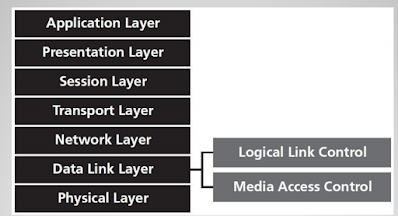Introduction to the OSI Model :
• OSI stands for Open Systems
Interconnection
• Created by International Standards
Organization
• Was created as a framework and reference
model to explain how different networking
technologies work together and interact
• Is not a standard that networking protocols
must follow
What the OSI Model Looks Like :
• Each layer has specific functions it is
responsible for
• All layers work
together in the
correct order to
move data around
a network
 |
| osi |
OSI Model Layer Mnemonics(leaing trick):
• Top to bottom
– All People Seem To Need Data Processing
• Bottom to top
– Please Do Not Throw Sausage Pizza Away
Physical Layer of OSI Model:
• Deals with all aspects of physically moving
data from one computer to the next
• Converts data from the upper layers into 1s
and 0s for transmission over media
• Defines how data is encoded onto the media
used to transmit the data
• Defined on this layer: Cable standards,
wireless standards, and fiber optic
standards
• Device example: Hub
• Used to transmit data
– Copper wiring, fiber optic cable, radio
frequencies, anything that can be used to
transmit data is defined on the Physical layer
of the OSI Model
People also ask by GOOGLE
framing in computer network || what is framing?
Data Link Layer of OSI Model:
• Is responsible for moving frames from node
to node or computer to computer
• Can move frames from one adjacent
computer to another, cannot move frames
across routers
• Encapsulation = frame
• Requires MAC address. or physical address
• Protocols defined include Ethernet Protocol
and Point-to-Point Protocol (PPP)
Data Link Layer of OSI Model (Continued)
• Device example: Switch
• Two sublayers: Logical Link Control (LLC) and
the Media Access Control (MAC)
 |
| datalink |
LLC and MAC Sublayers :
• Logical Link Control (LLC)
– Data Link layer addressing, flow control,
address notification, error correction .
Media Access Control (MAC)
– Determines which computer has access to
the network media at any given time
– Determines where one frame ends and the
next one starts, called frame synchronization
Network Layer of OSI Model
• Responsible for moving packets .
Network Layer of OSI Model:
• Responsible for moving packets (data) from
one end of the network to the other, called
end-to-end communications
• Requires logical addresses such as IP
addresses
• Device example: Router
– Routing is the ability of various network
devices and their related software to move
data packets from source to destination
Transport Layer of OSI Model :
• Takes data from higher levels of OSI Model
and breaks it into segments that can be sent
to lower-level layers for data transmission
• Conversely, reassembles data segments into
data that higher-level protocols and
applications can use
• Also puts segments in correct order (called
sequencing ) so they can be reassembled in
correct order at destination
Session Layer of OSI Model:
• Responsible for managing the dialog
between networked devices
• Establishes, manages, and terminates
connections
• Provides duplex, half-duplex, or simplex
communications between devices
• Provides procedures for establishing
checkpoints, adjournment, termination, and
restart or recovery procedures
People also ask by GOOGLE
Presentation Layer of OSI Model:
• Concerned with how data is presented to the
network
• Handles three primary tasks:
– Translation
– Compression
– Encryption
 |
Presentation Layer |
Application Layer of OSI Model:
• Contains all services or protocols needed by
application software or operating system to
communicate on the network
• Examples
– Firefox web browser uses HTTP (Hyper-Text
Transport Protocol)
– E-mail program may use POP3 (Post Office
Protocol version 3) to read e-mails and SMTP
(Simple Mail Transport Protocol) to send emails


Post a Comment
have you a any doubt then tell and if you want some topic then please tell .